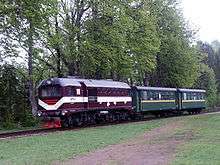Narrow gauge railways in Latvia

Narrow gauge train at Alūksne.
Around 1935 narrow gauge railways consisted of 536 km (335 miles) of 600 mm (1 ft 11 5⁄8 in) narrow gauge, 432 km (270 miles) of 750 mm (2 ft 5 1⁄2 in) narrow gauge, and 48 km (30 miles) of meter gauge.[1][2]
One public, one museum and some industrial peat railways survive.
Common Carrier
Track gauges are 750 mm (2 ft 5 1⁄2 in) narrow gauge unless otherwise specified.
- First Russian Supply Railway Company
- Valka–Rūjiena–Mõisaküla–Pärnu, branch of the Gulbene Line
- Liepāja–Alsunga line, 67 km, opened in 1932, extended to Kuldīga (20 km)
- Liepāja–Rucava line, 52 km, 600 mm (1 ft 11 5⁄8 in) narrow gauge military line, converted to 750 mm (2 ft 5 1⁄2 in) narrow gauge
- Liepāja–Aizpute railway, 48 km.
- Livonian Supply Railway Company
- Pāle–Staicele, 16 km, opened 1927
- Puikule–Aloja, 12 km.
- Riisselja–Ainaži, 76 km, closed 1975.
- Valmiera supply railway company, 600 mm (1 ft 11 5⁄8 in) narrow gauge, 1912:
- Wolmar supply railway at Valmiera.
Peat railway
The peat companies mainly use 750 mm (2 ft 5 1⁄2 in) narrow gauge, but there also exists 700 mm (2 ft 3 9⁄16 in) and 600 mm (1 ft 11 5⁄8 in) narrow gauge railways.
- Peat railway based at Dauguli
- Peat railway based at Ozoli
Other
- There is an historic train in Ventspils. The track gauge is 600 mm (1 ft 11 5⁄8 in) narrow gauge and the length is a 2 km circle. The locomotives are former "Brigadelok" steam locomotives. From 1918 until the early 1960s they ran a regular service from Ventspils along the coast to Mazirbe and further down to Talsi and Stende.
- The Riga Pioneer Railway, 2 km long, was in existence from 1956 to 1997.
References
This article is issued from Wikipedia - version of the 8/20/2015. The text is available under the Creative Commons Attribution/Share Alike but additional terms may apply for the media files.